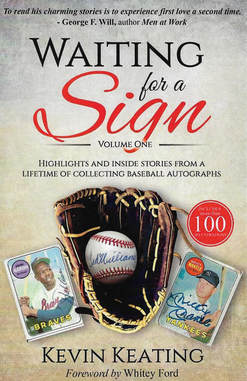
I got my first baseball autographs in 1970 at Municipal Stadium in West Palm Beach. The Atlanta Braves were playing a spring training game and had a table set up with players to sign programs. I got pitchers Pat Jarvis and George Stone.
Seven years later I attended another spring training game in West Palm Beach, this time between the Braves and New York Yankees. I saw Yankees manager Billy Martin leaning against a rail near the dugout and approached him. He took my Atlanta Braves program, signed it and handed it back without saying a word. I still have the program.
That’s amateur stuff compared to Kevin Keating, who is two years younger than I am but had already amassed thousands of autographs by 1977. Keating was motivated, fearless and showed plenty of creativity as he got players to sign whenever the Illinois resident ventured into downtown Chicago. He has collected his favorite autograph stories and compiled them into a very readable memoir.
In Waiting for a Sign, Volume 1: Highlights and Inside Stories From a Lifetime of Collecting Baseball Autographs (Word Serve Press; paperback; $21.95; 348 pages), Keating describes his adventures in 18 vividly written chapters. It is only fitting that now, Keating is the principal autograph authenticator for Professional Sports Authenticator. After all, he spent most of his youth collecting signatures and had more than 10,000 by the time he graduated from high school.
Keating would stand at the entrance to old The Executive House hotel in downtown Chicago, where visiting teams played. He always had a plan worked out and usually knew the players he sought by sight. Keating also sent letters to former players — including a self-addressed, stamped envelope — asking them questions about their careers. It was a sure-fire method of getting a response, and Keating shares some of the letters he received from men who played during the time of Babe Ruth and Ty Cobb.
The memorabilia craze was still decades away in 1969, so players and managers were more likely to sign autographs, particularly for kids. In that sense, Keating was fortunate. But even after he grew up and graduated from the United States Military Academy at West Point, Keating pursued his hobby.
What resulted were Charles Kuralt-type “On the Road” journeys, where Keating would visit former players. He developed some warm friendships, and, in addition to collecting autographs, compiled some dynamite interviews.
Keating opens Waiting for a Sign with autograph memories from his childhood, and how Chicago Sun-Times columnist Bob Greene profiled him in a piece that got the 14-year-old in trouble (he was playing hooky to get autographs and the column blew the cover off that tactic).
The best chapter in the book is Keating’s interaction with Hall of Fame infielder Joe Sewell. Keating not only became friends with Sewell and his family, he also learned a great deal about the game and found answers to baseball questions that only a veteran of the 1920s and ’30s would know.
The trip to visit Sewell was part of a Deep South excursion, as Keating also traveled to meet Hall of Famer Johnny Mize at his Georgia home. He played a memorable round of golf with the “Big Cat” just a few weeks before Mize’s death in 1993.
The story about Hall of Fame shortstop Lou Boudreau, who signed a scorecard on the day Keating’s brother was born, was a fun read. Boudreau was more than happy to sign the same scorecard on ensuing years to commemorate the birth of Keating’s younger sibling.
Anecdotes about Yogi Berra, Warren Spahn, Whitey Ford show that Keating not only secured some classic autographs but made some lifelong friends. These are stories that young fans can only dream about.
A particularly funny chapter involved Joe DiMaggio. Keating discovered that the Yankee Clipper’s sister signed most of the autograph requests, so he bought a large poster and asked DiMaggio to sign it. Fortunately, a friend was there to take photos, and when DiMaggio realized he would be violating his contract because the poster was made by a competitor, his expression was priceless. Keating includes those photos in an amusing series.
Keating’s autograph collection reads like a who’s who of baseball: Willie Mays, Hank Aaron, Roberto Clemente, Ted Williams, Stan Musial, Ford and Berra. Keating managed to get a Mickey Mantle autograph but never met the slugger. In fact, Keating made the mistake of sending cards to the Mick and never saw them again. For $95, an associate Keating trusted got Mantle to sign a photograph of himself with his former teammate, Roger Maris. Maris had passed away, so the inscription Mantle wrote on the photograph was touching.
With so many autographs — and stories — a second volume made sense and it will be published in the future. Keating is promising stories about Casey Stengel, George Sisler, Harmon Killebrew, Bob Feller, George Brett, Chuck Connors, Buck O’Neil and even actor Charlie Sheen.
Waiting for a Sign is a fast, pleasant read. Keating does not go into the technical aspects of autographs, although his expertise in the field would probably reveal some fascinating details. Instead, Keating takes a more personal and informal approach, and it gives the reader a front row seat as the expert autograph collector spins stories from his past.
By the way, Keating autographed my review copy of Waiting for a Sign and personalized it, too. The signature, in case you wondered, was magnificent.
 RSS Feed
RSS Feed
